1 [In]definite optimism vs. [in]definite pessimism
In Zero to One, Peter Thiel presents a powerful framework for understanding cultural attitudes towards technology. First: are people optimistic or pessimistic about the future? Second: do they even think they know what the future will look like, or do they think the future is merely indeterminate/unknowable? This leads to four possible attitudes:
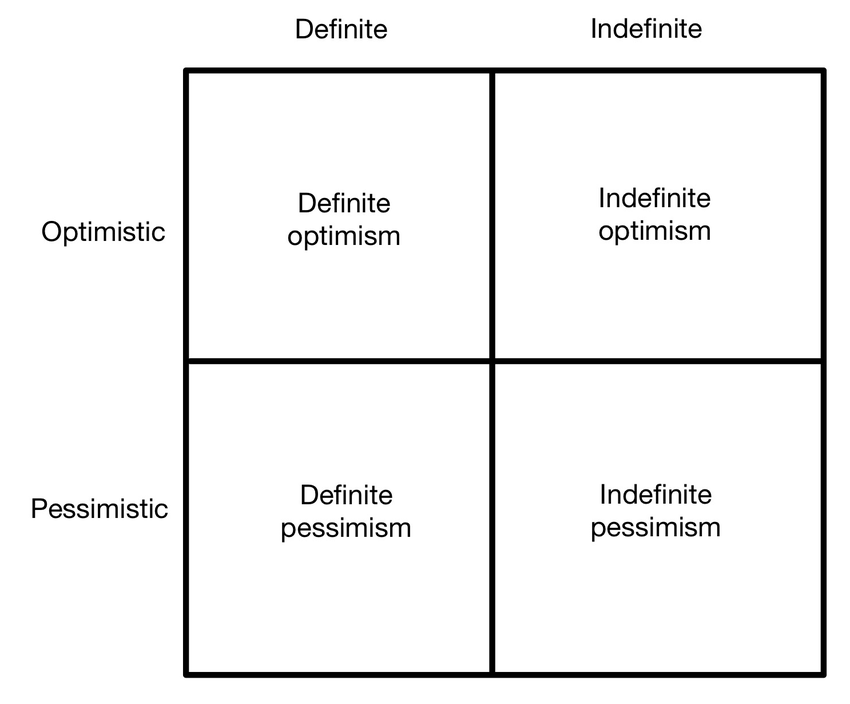
-
Indefinite pessimism. "An indefinite pessimist looks out onto a bleak future, but he has no idea what to do about it."
-
Definite pessimism. "A definite pessimist believes the future can be known, but since it will be bleak, he must prepare for it."
-
Indefinite optimism. "To an indefinite optimist, the future will be better, but he doesn’t know how exactly, so he won’t make any specific plans." This has been the predominant attitude in the U.S. for most of our lives:
Instead of working for years to build a new product, indefinite optimists rearrange already-invented ones. Bankers make money by rearranging the capital structures of already existing companies. Lawyers resolve disputes over old things or help other people structure their affairs. And private equity investors and management consultants don’t start new businesses; they squeeze extra efficiency from old ones with incessant procedural optimizations.
-
Definite optimism. "To a definite optimist, the future will be better than the present if he plans and works to make it better." This was the classical attitude of the U.S. during the first half of the 20th century:
From the 17th century through the 1950s and ’60s, definite optimists led the Western world. Scientists, engineers, doctors, and businessmen made the world richer, healthier, and more long-lived than previously imaginable.
Some concrete examples of definite optimism from this era:
The Empire State Building was started in 1929 and finished in 1931. The Golden Gate Bridge was started in 1933 and completed in 1937. The Manhattan Project was started in 1941 and had already produced the world’s first nuclear bomb by 1945. Americans continued to remake the face of the world in peacetime: the Interstate Highway System began construction in 1956, and the first 20,000 miles of road were open for driving by 1965. Definite planning even went beyond the surface of this planet: NASA’s Apollo Program began in 1961 and put 12 men on the moon before it finished in 1972.
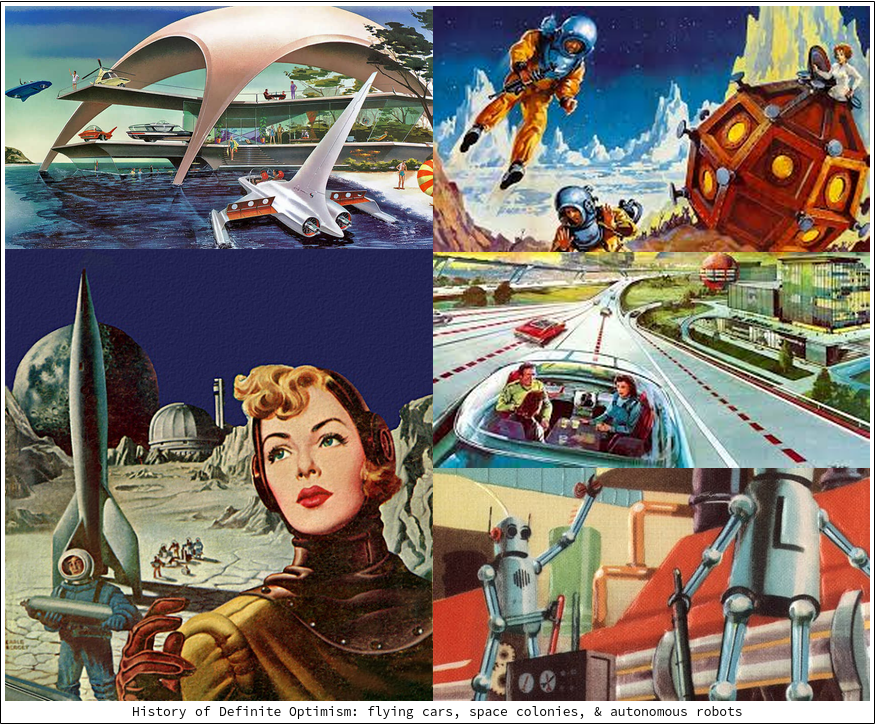
2 The U.S. has shifted from indefinite optimism to definite pessism
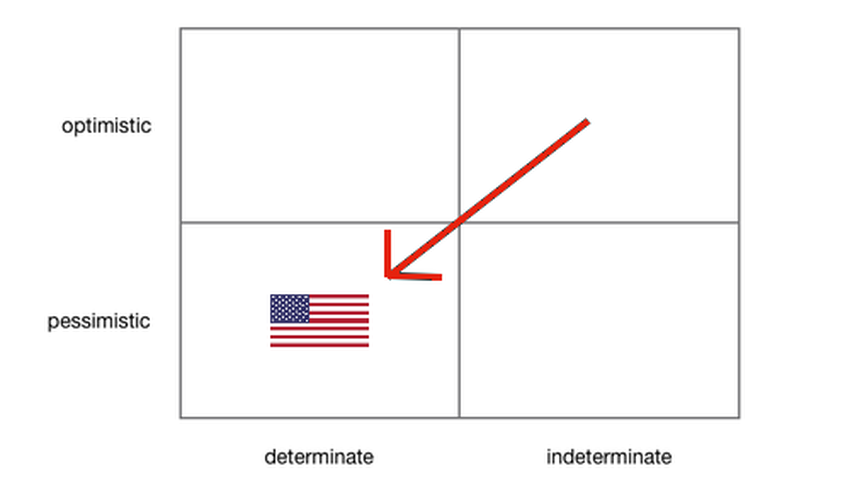
When Zero to One was written (2012-2014), Thiel thought the U.S. was living under indefinite optimism. But I think this has now changed. Much like in early 20th century, we are living in a world today with highly specific and culturally recognized technological projects: things like AGI, crypto, self-driving cars, and VR/AR. But unlike the past, the predominant cultural view is that these technologies are going to make us worse off, not better. Only a smaller minority of technologists and investors remain optimistic about these projects:
| Definite Project | Optimistic View (Minority) | Pessimistic View (Majority) |
|---|---|---|
| AGI | A world without human toil | A world without human jobs |
| Self-Driving Cars | Frees up driver time; safer & less congested roads | Frees up driver jobs |
| Space Industry | An economically feasible way to become a space-faring civilization | An economically profitable way for rich people to flee to space and/or siphen resources away from earth |
| Autonomous Delivery Networks | Instant-delivery packages | Instant-delivery consumerism |
| Crypto | Freedom from bad states & bad regulations | Freedom from good states and good regulations |
| VR/AR | Productive, multi-screen computing device; a "Tool for the Mind" | Facebook Metaverse: a place for humans to zonk out in an ad-infested corporate Social Network |
3 VR vs. definite pessism
So what about VR?
3.1 Until the Metaverse, VR lacked a "definite" plan for the future
VR/AR is now a definite trend that is widely recognized in our culture. Superficially, things are looking good: there's lots of headsets being purchased, and a lot of financial investments being made. Rumor has it that Facebook alone has been spending $$5$B pear year on VR/AR, and this after spending $2B on Oculus in 2014! But has VR really changed the world? It seems to us that while a lot of people have tried VR, not a lot of people have stayed using VR:
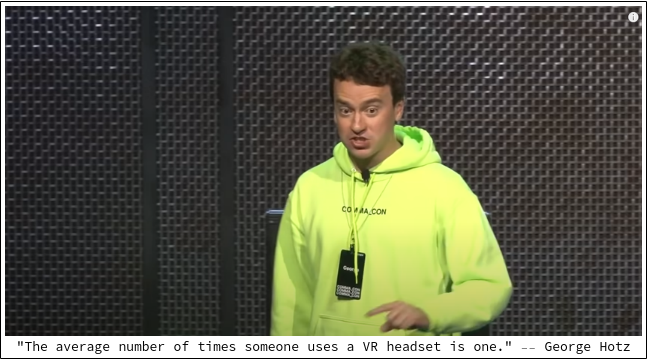
Up until recently, people sensed there was potential for VR, but they didn't necessarily know where it was all going…until Meta.
3.2 Zuckerberg has offered a definite plan for VR, but it's not clear it's an optimistic one
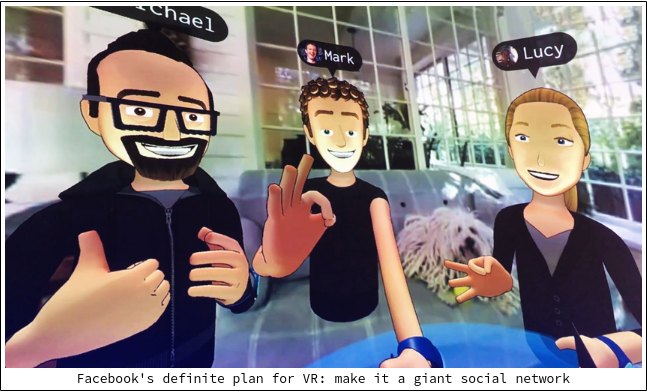
We'd like to first praise Zuck before objecting to his plan. He's one of the few large-cap founder CEOs still at least trying to execute against an ambitious technology plan for a future radically different than our own. Can anyone name a wildly ambitious project that Google, Apple, Netflix, or even Amazon is betting their company on? Not really. Over the last 10+ years, the people in charge of these companies have largely checked out from the innovation process:
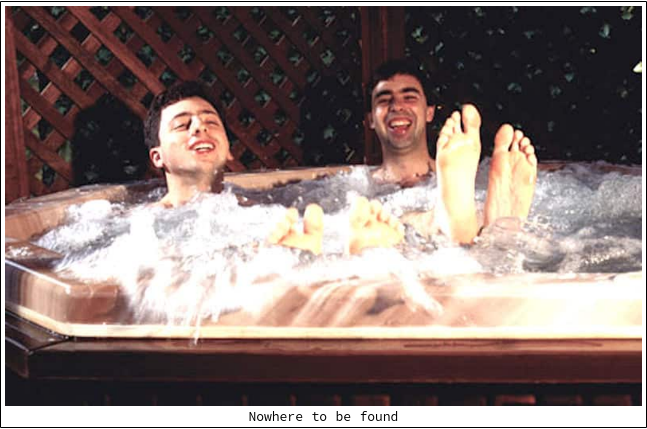
That being said, we disagree strongly with the direction of Zuck's plan for VR, which essentially boils down to "make VR a huge corporo-social network – focused on gaming & entertainment experiences mainly – and then jam everything else through that framing".
To us, a more optimistic vision for the future is specifically VR computing, not VR social networking. More details of our argument against Facebook's vision for VR can be found in this separate post.
3.3 A definite optimist view for VR: a Tool for Thinking
Social networking in VR isn't 100% bad, but it's not the thing that makes VR so cool, or gives us as much optimism about its future. Maybe we're just not as excited about VR socializaing as Facebook is.
Our optimistic plan for VR is one that emphasizes platform as a Tool for Thought, which is a continuation of the original vision for Personal Computing before the era of social networks.
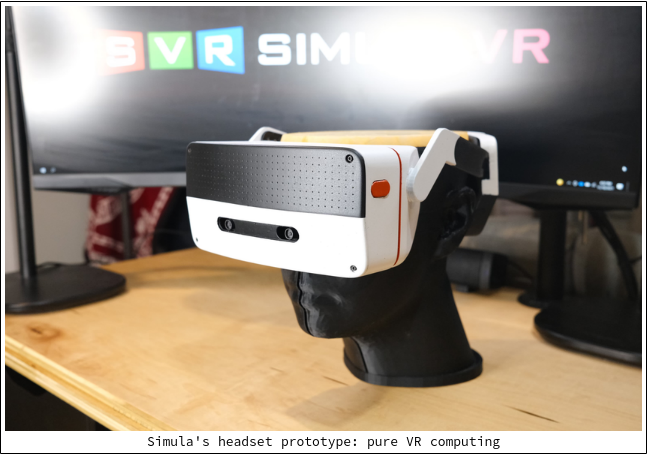
To us, what's cool about VR/AR is that it provides people with new and more intuitive ways to interact with their computers, and a way to get more stuff done in general. Our optimistic, long-term plan for VR/AR headsets is that they
- (i) be no more invasive than a pair of eye glasses
- (ii) come equipped with display resolutions matching the human eye
- (iii) are controllable with hand gestures, eye gaze, and (eventually) our thoughts
- (iv) enhance our thinking with new classes of applications which make explicit & special use of the VR medium
Even for 2D applications, VR is fundamentally superior to PCs & laptops. We'll know we're making progress when the majority of knowledge workers in the developed world are using exclusively VR/AR workstations.
4 How to help us out
If you're reasonably sure you want to purchase our headset, and you'd like to be notified an hour before the campaign starts (to maximize chances of getting early discounts), add your email to our new "Early Kickstarter Backers" list:
If you'd like to support us in other ways:
- Share. Follow us on Twitter and share our campaign to your followers!
- Discuss. If you have questions about our headset, you can check out /r/simulavr and our Discord.
- Join. If you're interested in joining our team, send resumes over to info@simulavr.com. We will start hiring for positions in February, and are looking for talented electrical, mechanical, and software engineers.
